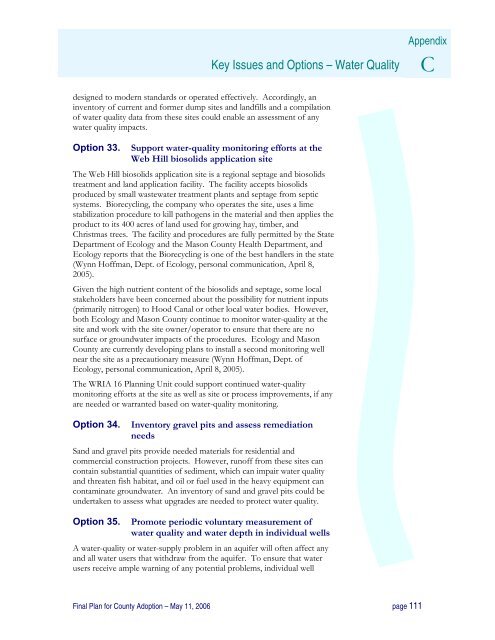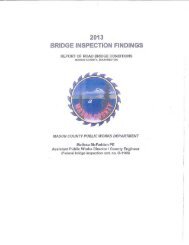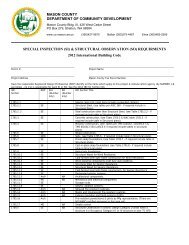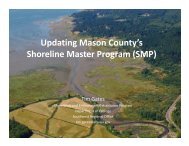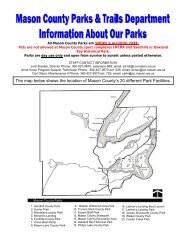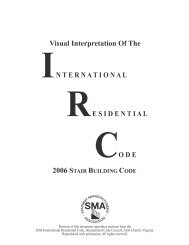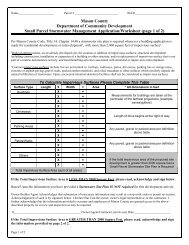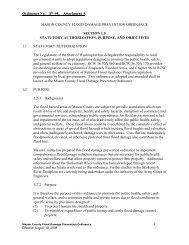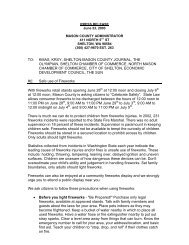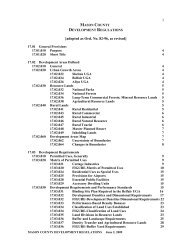Watershed Management Plan - Mason County
Watershed Management Plan - Mason County
Watershed Management Plan - Mason County
You also want an ePaper? Increase the reach of your titles
YUMPU automatically turns print PDFs into web optimized ePapers that Google loves.
Key Issues and Options – Water Quality<br />
Appendix<br />
C<br />
designed to modern standards or operated effectively. Accordingly, an<br />
inventory of current and former dump sites and landfills and a compilation<br />
of water quality data from these sites could enable an assessment of any<br />
water quality impacts.<br />
Option 33.<br />
Support water-quality monitoring efforts at the<br />
Web Hill biosolids application site<br />
The Web Hill biosolids application site is a regional septage and biosolids<br />
treatment and land application facility. The facility accepts biosolids<br />
produced by small wastewater treatment plants and septage from septic<br />
systems. Biorecycling, the company who operates the site, uses a lime<br />
stabilization procedure to kill pathogens in the material and then applies the<br />
product to its 400 acres of land used for growing hay, timber, and<br />
Christmas trees. The facility and procedures are fully permitted by the State<br />
Department of Ecology and the <strong>Mason</strong> <strong>County</strong> Health Department, and<br />
Ecology reports that the Biorecycling is one of the best handlers in the state<br />
(Wynn Hoffman, Dept. of Ecology, personal communication, April 8,<br />
2005).<br />
Given the high nutrient content of the biosolids and septage, some local<br />
stakeholders have been concerned about the possibility for nutrient inputs<br />
(primarily nitrogen) to Hood Canal or other local water bodies. However,<br />
both Ecology and <strong>Mason</strong> <strong>County</strong> continue to monitor water-quality at the<br />
site and work with the site owner/operator to ensure that there are no<br />
surface or groundwater impacts of the procedures. Ecology and <strong>Mason</strong><br />
<strong>County</strong> are currently developing plans to install a second monitoring well<br />
near the site as a precautionary measure (Wynn Hoffman, Dept. of<br />
Ecology, personal communication, April 8, 2005).<br />
The WRIA 16 <strong>Plan</strong>ning Unit could support continued water-quality<br />
monitoring efforts at the site as well as site or process improvements, if any<br />
are needed or warranted based on water-quality monitoring.<br />
Option 34.<br />
Inventory gravel pits and assess remediation<br />
needs<br />
Sand and gravel pits provide needed materials for residential and<br />
commercial construction projects. However, runoff from these sites can<br />
contain substantial quantities of sediment, which can impair water quality<br />
and threaten fish habitat, and oil or fuel used in the heavy equipment can<br />
contaminate groundwater. An inventory of sand and gravel pits could be<br />
undertaken to assess what upgrades are needed to protect water quality.<br />
Option 35.<br />
Promote periodic voluntary measurement of<br />
water quality and water depth in individual wells<br />
A water-quality or water-supply problem in an aquifer will often affect any<br />
and all water users that withdraw from the aquifer. To ensure that water<br />
users receive ample warning of any potential problems, individual well<br />
Final <strong>Plan</strong> for <strong>County</strong> Adoption – May 11, 2006 page 111


